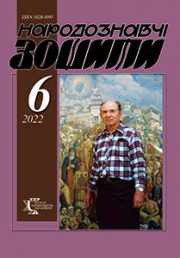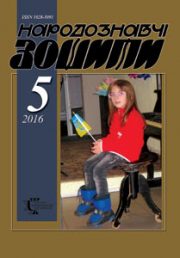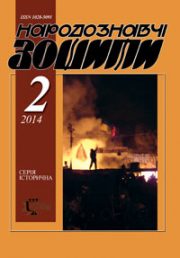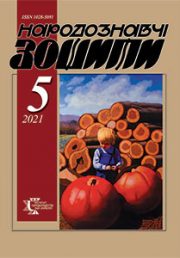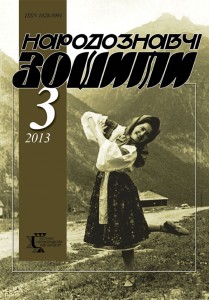2013 year, issue 3
Contents
On the ground of her own folklore records made along Northern Moldavian lands the author has explained some features of ritual semantics, functioning as well as poetic order of pairing songs within the framework of less-known St. Andrew’s Eve ceremony of matching. So local as regional specificity of those songs and their connections with all-Ukrainian system of folklore have been traced.
Keywords: a pairing song, Ukrainians of North Moldova, tradition, ritual, poetics.
Keywords: a pairing song, Ukrainians of North Moldova, tradition, ritual, poetics.
In the article grounded upon field ethnographic materials and published sources has been presented analysis in the process of choice and preparation of constructive wood, a practice spread in Western Polisia. In the study have been considered some constructive species, their technological properties, criteria of qualitative setting etc. Especial place has been occupied by a complex of customs, beliefs and superstitions accompanying the processes of choice and preparation as for this constructive material.
Keywords: Western Polisia, constructive wood, pine-tree, oak, adler, aspen
Keywords: Western Polisia, constructive wood, pine-tree, oak, adler, aspen
In the article have been considered some especial forms of Ukrainians’ popular religiosity (as pilgrimages, crucessions, supper meetings, erection of crosses etc.) arisen and functioned on the ground and under the influence of crisis-born socio-political conditions of 1920s under-Soviet Ukraine. Traditional basis was proved and novational components, specific features of these practices and connected with them beliefs, notions and folklore belonging were found, to brightest manifestations of people’s religious piety and anti-regime frames of mind of that time.
Keywords: popular religious piety, miracle, pilgrimage, plot, spreading.
Keywords: popular religious piety, miracle, pilgrimage, plot, spreading.
The article has brought a 1930 report by Yelyzaveta Levytska, member of Ukrainian Archaeological Commission, on architecture and murals of the wooden synagogue of the town of Mykhalpil. Contents and findings of the paper have been critically reviewed and their values for scientific projects emphasized. In the focus of study has been a perception of artistic traditions originated at Jewish synagogue architecture and wall paintings in particular, a point differentiating this study from other similar ones processed during the first third of the XX c (H.Pavlutsky, P. Zholtovsky and other art scholars); quite unique character of synagogue murals developed in Podilia at the XVIII c. is underlined.
Keywords: wooden synagogues, Podilia, Mykhalpil, Jewish traditions, architecture, murals, iconography, symbolism.
Keywords: wooden synagogues, Podilia, Mykhalpil, Jewish traditions, architecture, murals, iconography, symbolism.
Konopka Volodymyr. Areal characteristics of harvest caroling tradition in Ukraine. P. 447-455
The article has dealt with one of most important components of traditional Ukrainian culture, viz. a folk calendar ritual practice. By means of thorough study of ethnographic field materials the author has described and analysed the customs of caroling during harvest season, an issue not yet sufficiently considered in scientific publications.
Keywords: Ukrainian, harvest, zazhynky, caroling, the first sheaf.
Keywords: Ukrainian, harvest, zazhynky, caroling, the first sheaf.
Nykorak Olena. On local peculiarities in artistic design of hutsul zapaskas. P. 456-478
The article has brought some results of study in originality of artistic features of Hutsul zapaskas considered as for their fabrics, techniques of weaving, ornamental motives, schemes of placement and colouring. Main types of zapaska compositions have been defined as well as most important centres of their production in Galician, Transcarpathian and Bukovinian parts of Hutsul land.
Keywords: Hutsul zapaskas, types, centres, ornamental motives, compositional schemes, colouring, rapport, rhythm.
Keywords: Hutsul zapaskas, types, centres, ornamental motives, compositional schemes, colouring, rapport, rhythm.
Taras Yaroslav. On stone galleries of moldavian dwelled homesteads. P. 479-494
In the article have been considered stone galleries of living huts in Moldavia as well as their architectural-constructive and decorative design and finishing. Especial attention has been paid to Moldavian order of dwelled home and its components with presentation of variants, details and ornamented motifs. The study is exhaustingly accompanied with graphical illustrations.
Keywords: Moldavia, gallery, order, head of a column, keystone.
Keywords: Moldavia, gallery, order, head of a column, keystone.
This article written upon the basis of published and archival data as well as author’s own field materials has brought an analytic study in matrimonial fortune-telling prescience built on the interpretation of a first met male. Owing to personal contact with this representative of «an another world» a girl might to find out her future husband’s name.
Keywords: fortune-telling (mantic quests, divinations), first on-comer, beggar, name, ritual meal, notes.
Keywords: fortune-telling (mantic quests, divinations), first on-comer, beggar, name, ritual meal, notes.
In the article has been recommended a new concept reflecting structural unity of pre-historic built ensembles and architecture – a viewpoint presented by intellectual testimonies of megalithic structures. Concrete example of cult megalithic object in the territory of Ukraine has been used as a ground argument for author’s theory as for the source of ancient architecture and, correspondingly, that of modern architecture.
Keywords: the megalithic construction, the cave ensemble, megalithic geometry, megalithic model, school of the megalithic building, Trypillian culture.
Keywords: the megalithic construction, the cave ensemble, megalithic geometry, megalithic model, school of the megalithic building, Trypillian culture.
The article is devoted to L.M. Sukha, widely-known Ukrainian scientist, ethnologist and anthropologist, staff researcher of the Ethnology Institute, National Academy of Sciences of Ukraine during the second third of XX c. Especial attention has been paid to Sukha’s research activities and investigating interests, as well as to analysis in her major scientific works less-know to wider circles of public.
Keywords: L. Sukha, Institute of Ethnology, the Ukrainian National Academy of Sciences, Museum of Ethnology and Crafts, field research, ethnologist.
Keywords: L. Sukha, Institute of Ethnology, the Ukrainian National Academy of Sciences, Museum of Ethnology and Crafts, field research, ethnologist.
The article has presented a general review of ethnographic and regional scientific materials kept at the Kalush Ivan Franko Museum with main data as for its activities during two last decades (1992—2012)
Keywords: Ivan Franko, Kalush Ivan Franko Museum, ethnography, Pidhirky, Kalush.
Keywords: Ivan Franko, Kalush Ivan Franko Museum, ethnography, Pidhirky, Kalush.
In the article have been considers some examples of iconography spread in the second half of XVIII c. along Western Podilia with the task to discover the impacts of artistic styles and corresponding means of expression; definitions have been given to characteristic features and trends in interpretations of iconographic images; innovations in contents, compositions and visual iconological approaches, influenced by Western art and constant national tendencies have been traced.
Keywords: Baroque, means of expression, Western Podilia, icon, icon-painting, classicism, Rococo style, trends.
Keywords: Baroque, means of expression, Western Podilia, icon, icon-painting, classicism, Rococo style, trends.
Shtanko Kateryna. On typologic schemes of research-works in synesthesia phenomena. P. 538-542
In the paper have been analyzed some main typological schemes used in consideration of synesthesia phenomena. Complications in interpretation and conceptualisations of synaesthesia along various fields of scientific knowledge have been presented.
Keywords: synesthesia, typological scheme, intermodal perception.
Keywords: synesthesia, typological scheme, intermodal perception.
The article for the first time has presented a review of special objects situated in mountain highlands. In the course of research-work a statement has been proven that many aspects of the problem were not sufficiently investigated until nowadays, particularly in Ukraine. Some specific characteristics of historical development as for discussed objects — in the world as well as in Ukraine — had been thoroughly studied and analyzed with subsequent creation of the whole picture of constructions. In the course of research-work some light has been thrown upon most striking examples of highlands architecture; the sum of ones has presented a basis for author’s own classification in the whole variety of objects. Conclusion has been made that in Ukraine with its rich natural mountain conditions the development of highlands architecture was stopped during the World War II. At the same time the temp of progress in those objects has only grown abroad and especially in Europe with corresponding quite positive results. The attention to mentioned issue has become a guarantee for safe sojourn under extreme highland conditions.
Keywords: special objects of highlands, mountain asylum, observatory, residential buildings, engineering conctructions.
Keywords: special objects of highlands, mountain asylum, observatory, residential buildings, engineering conctructions.
Yanchuk Yulia. On some features of Rostyslav Hluvko’s graphical artistry. P. 554-557
Creative works by Rostyslav Hluvko (1927—1990), maître of graphical art have been considered in the article. An attempt of systematization has been made in artist’s enormous heritage including printed products, laying projects and illustrations of books, journals, newspapers, various genre applied graphical sheets, thematic cycles of drawings, sketches of painted compositions etc. Scientific analysis in artifacts has been performed in accordance with general configuration of Rostyslav Hluvko’s creative inclinations, within the framework of Ukrainian Fine Art, its history and contemporary state.
Keywords: Rostyslav Hluvko, Kremenets, London, graphical art, genres of applied graphics, illustration, book design.
Keywords: Rostyslav Hluvko, Kremenets, London, graphical art, genres of applied graphics, illustration, book design.
Odrekhivsky Vasyl. On anthropomorphism in contemporary sculpture. P. 558-561
In the article have been considered some examples of contemporary three-dimensioned art-objects, installations etc. that tend to a category of monumental sculpture. Analysis has been processed as for their similarity to a human body and in authors’ endeavor of turn to a problem field of philosophy, in artists’ avoidance of intermediate image of figurative forms.
Keywords: anthropomorphism, sculpture, body, organics
Keywords: anthropomorphism, sculpture, body, organics
Myskiv Yaroslav. On some actual problems in teacing of present-day designing. P. 562-565
In the article some light has been thrown upon the problem of designer’s place in society as well as certain stages of students’ educative and creative progress during their training in Lviv National Academy of Arts, Sevastopol Dept. Especial attention has been paid to factors determining basic qualities of education, peculiarities of academic training of future designers under the present-day conditions , lecturing approaches of tutoring academic staff being most important factor of the higher schooling.
Keywords: department, design, dress design, educational process, interior design ,graphic design, artistic genre, art exhibition.
Keywords: department, design, dress design, educational process, interior design ,graphic design, artistic genre, art exhibition.
Mykhailo Chornopysky. Reflections on read-through matters. P. 566-571
read »
